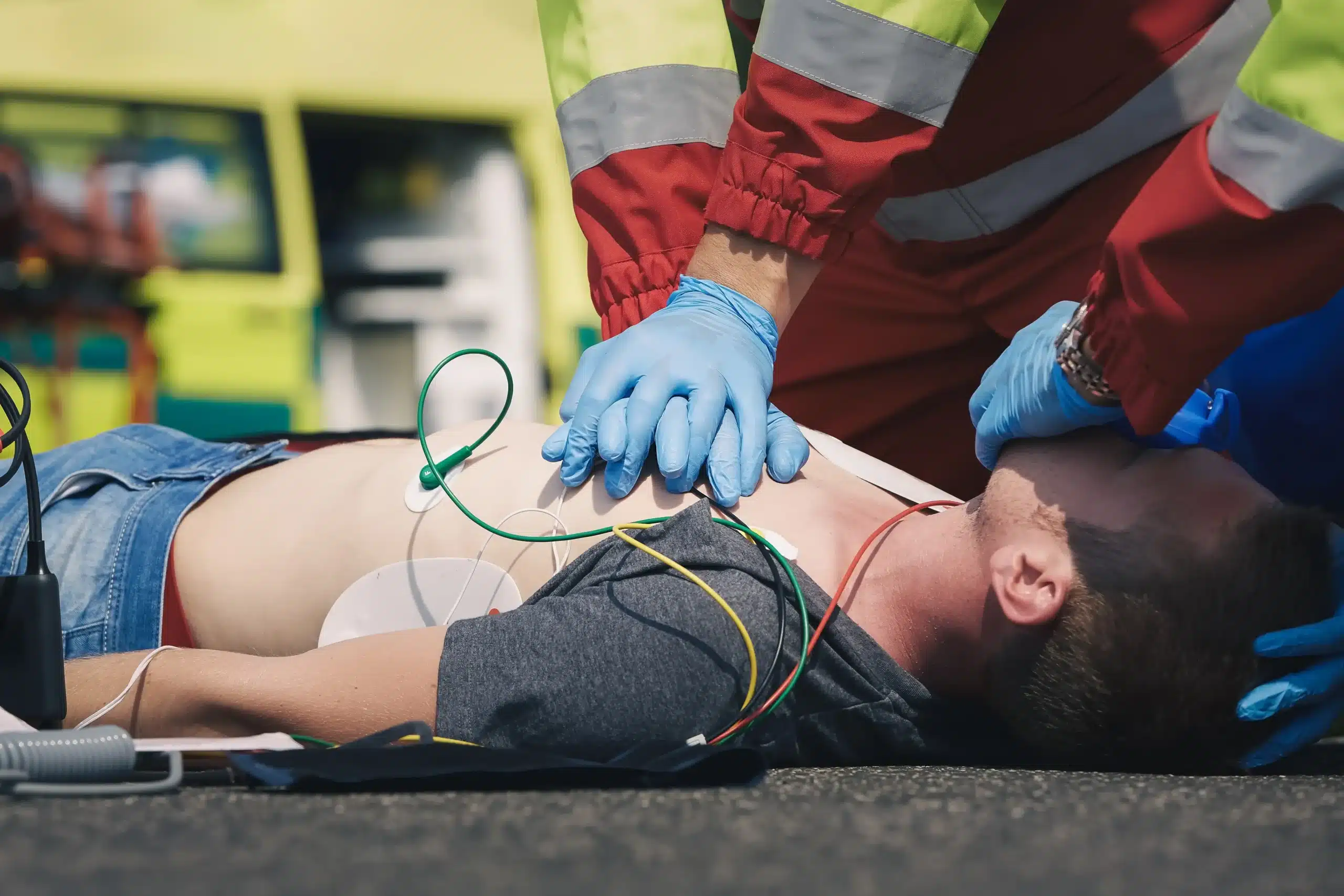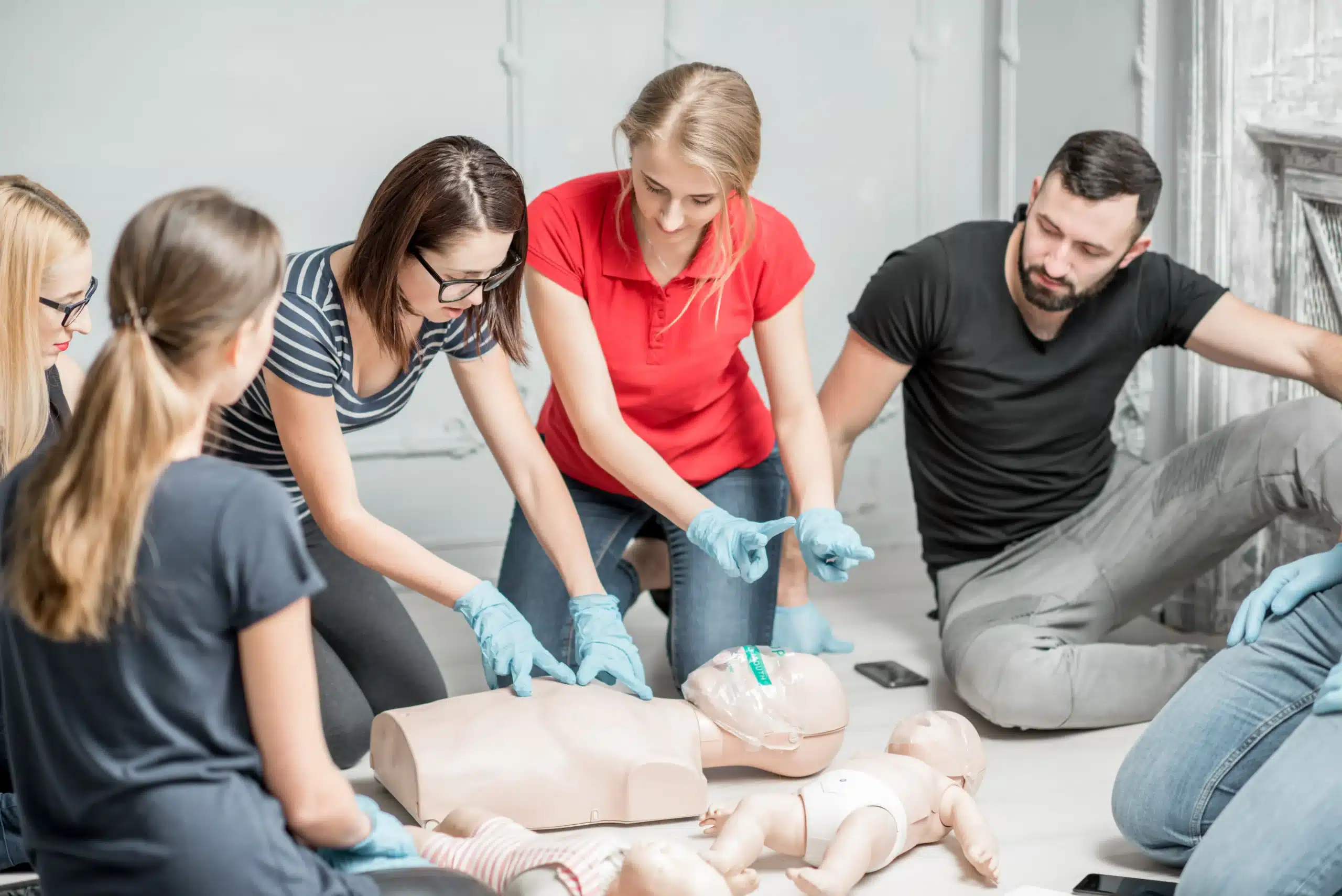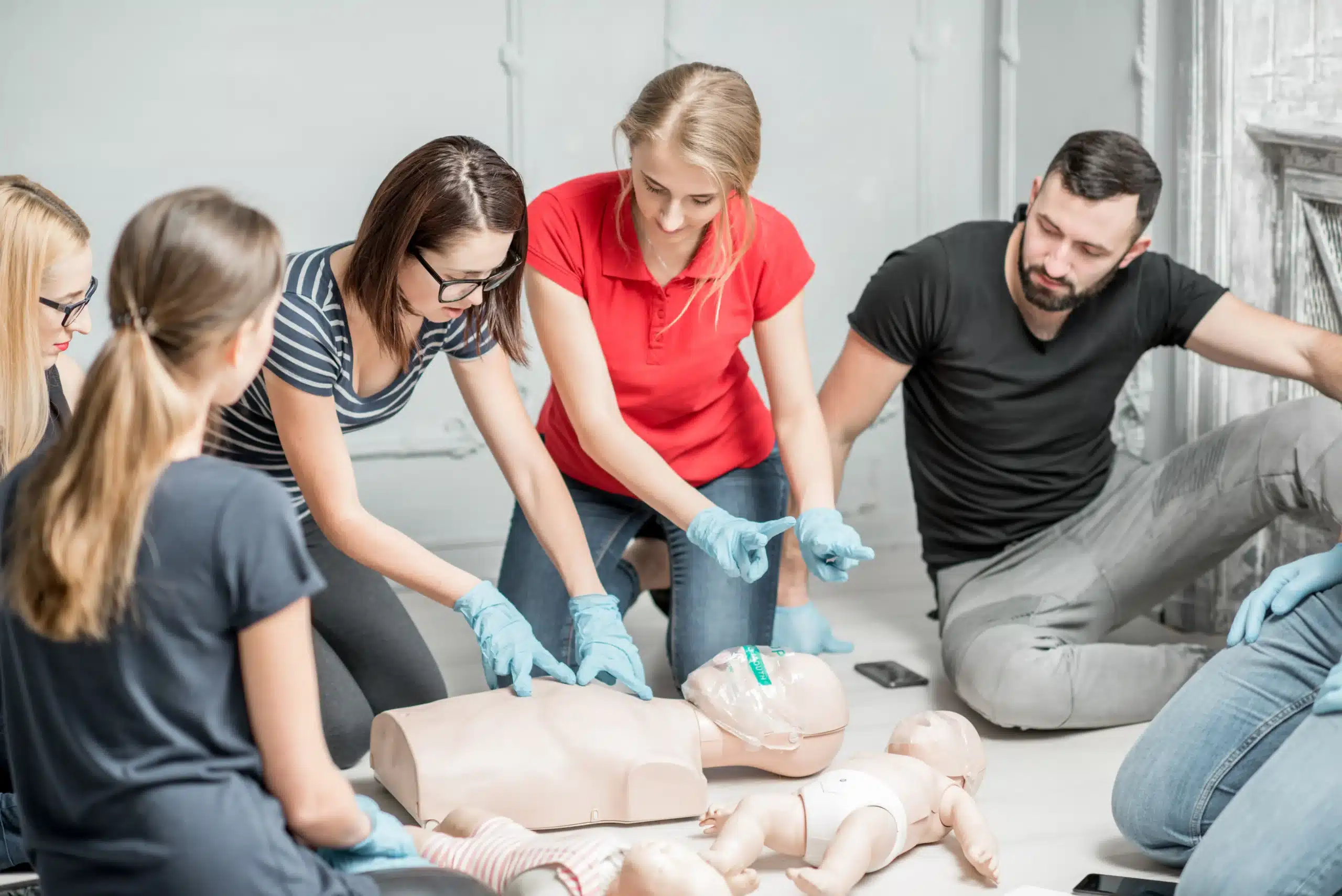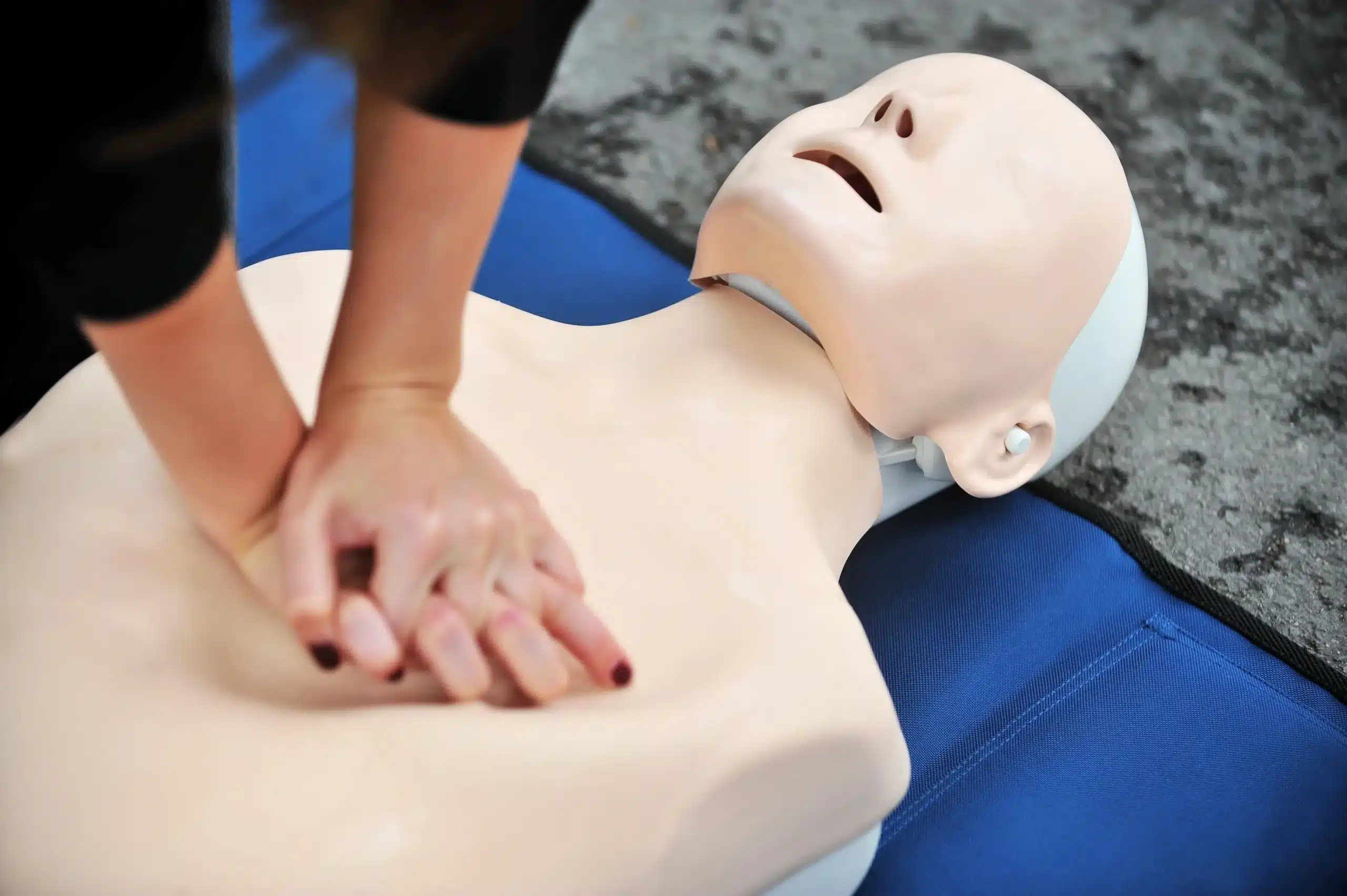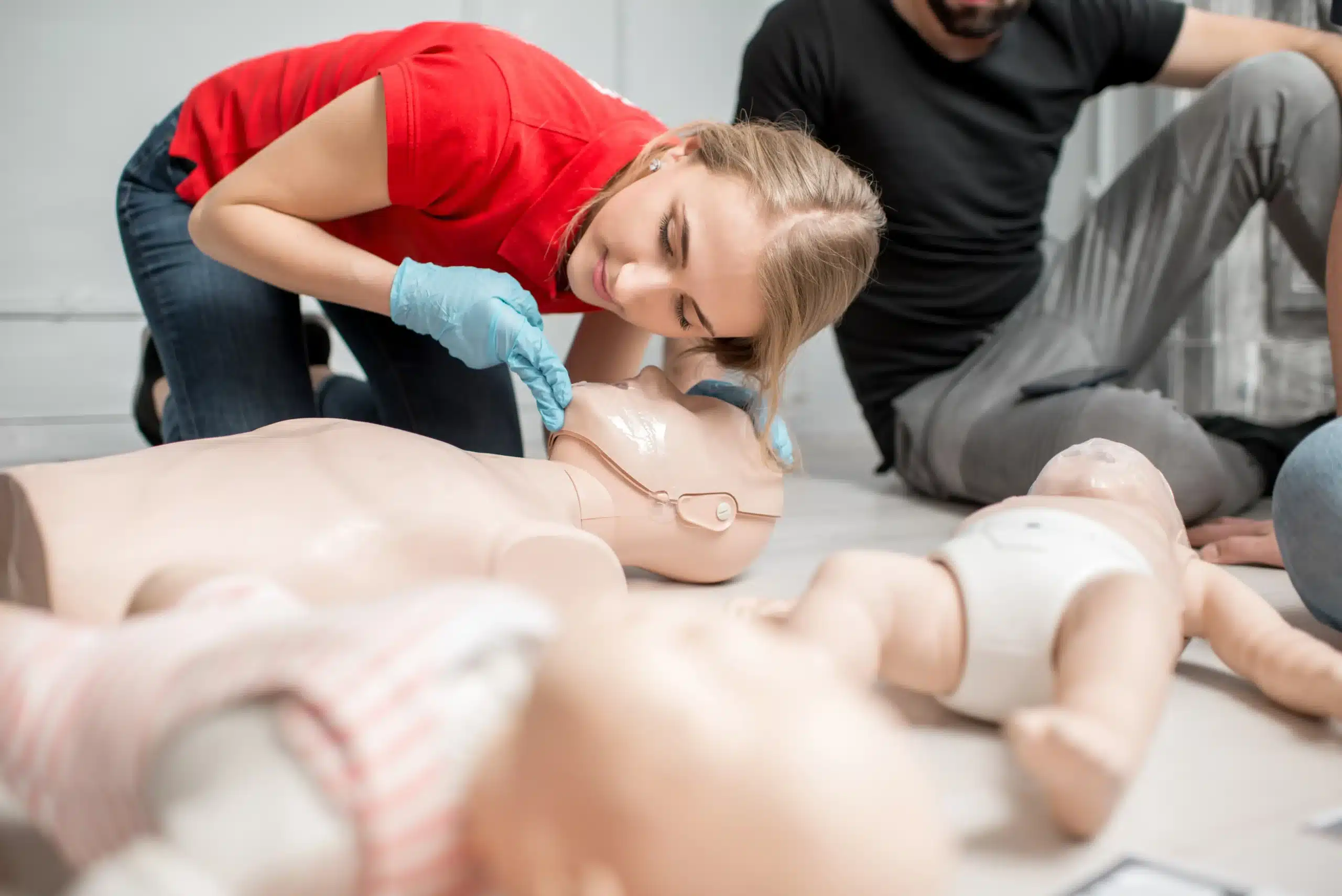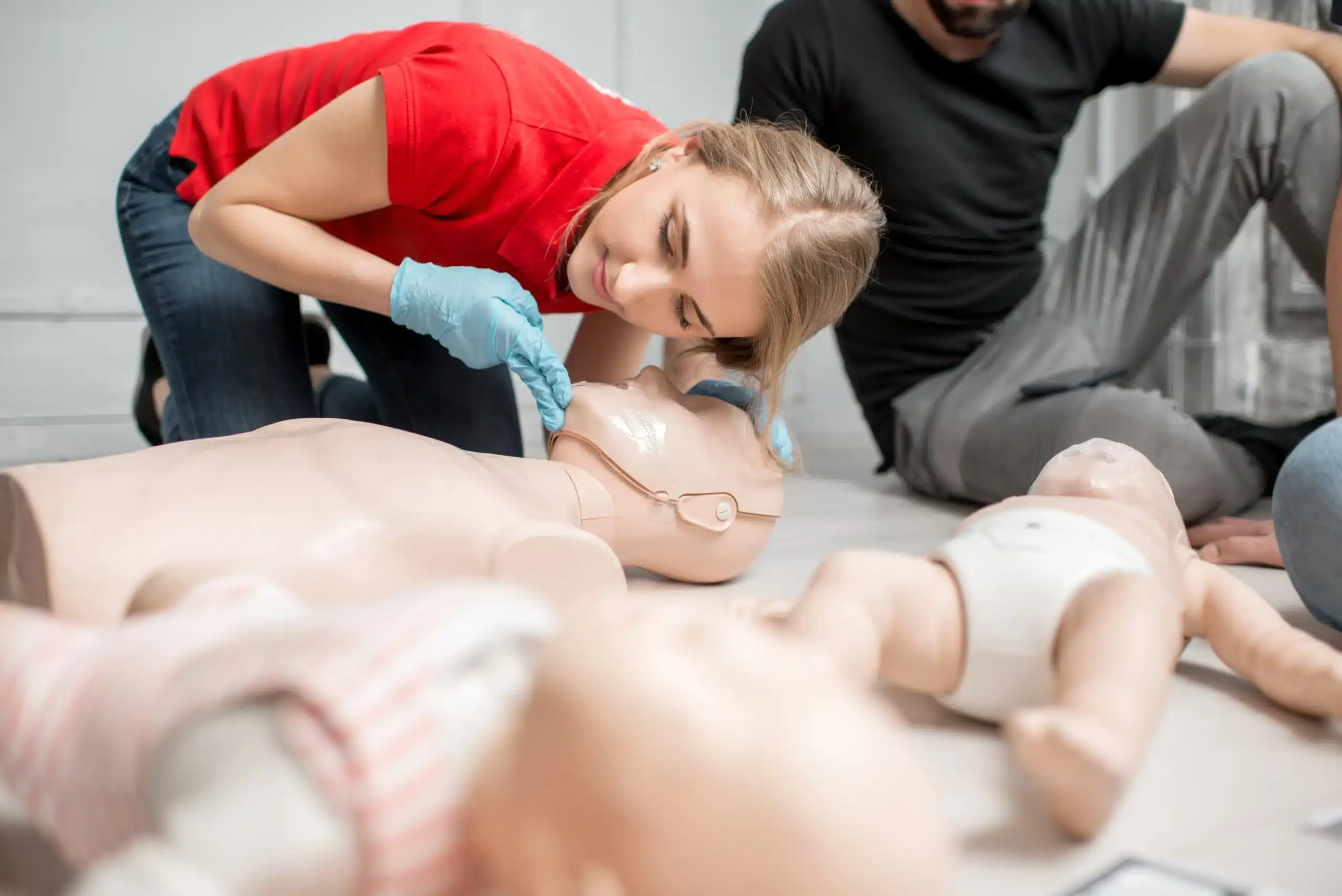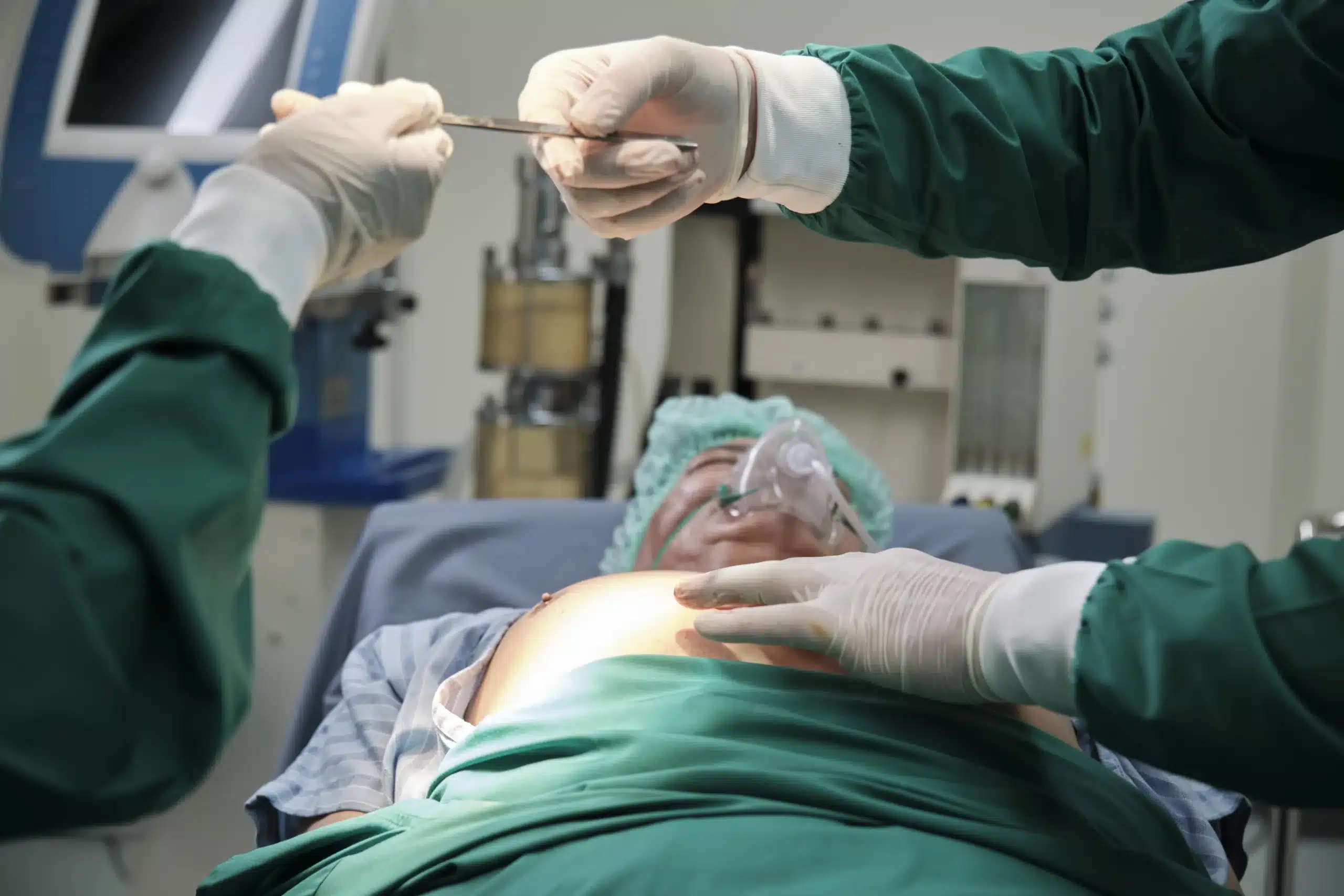Emergencies happen, and knowing how to respond effectively can save a life. CPR is a powerful skill that empowers you to act quickly and confidently when every second counts. If you’ve been typing “CPR courses near me” into your search bar, you’re taking the first step toward becoming a vital link in the chain of survival. This comprehensive guide will walk you through everything you need to know about CPR training, from finding the right course to maintaining your skills long-term.
Key Takeaways
- CPR training empowers you to save lives: Find a course—in-person, online, or blended—that fits your schedule and learning style. From healthcare providers to everyday people, CPR skills are invaluable in emergencies.
- Select a CPR course that meets your needs: Consider cost, instructor experience, and hands-on practice opportunities. A quality course will give you the confidence to act quickly and effectively.
- Stay sharp with regular practice and continuing education: CPR skills require upkeep. Practice regularly, refresh your knowledge, and consider advanced training to maintain your life-saving abilities.
What is CPR?
CPR, or cardiopulmonary resuscitation, is a life-saving technique used when someone’s heart stops beating, a condition known as cardiac arrest. It’s a combination of chest compressions and sometimes rescue breaths, designed to restore blood flow and get oxygen to the brain and vital organs. CPR buys precious time until professional medical help arrives.
The American Heart Association considers CPR a critical part of the “Chain of Survival,” the sequence of actions that improves the odds of surviving cardiac arrest. This chain begins with recognizing the emergency and calling 911, followed immediately by starting CPR. If you’re not trained in CPR, the American Heart Association recommends performing hands-only CPR (just chest compressions) until help gets there.
While the core principles remain the same, CPR techniques can differ slightly depending on the person’s age. Hands-only CPR is often enough for adults and teens, while infants and children might need both chest compressions and rescue breaths. Healthline offers a helpful guide on these variations. Learning CPR, regardless of the specific technique, equips you to respond effectively in a crisis and potentially save a life. The Red Cross is another excellent resource for learning more about CPR and its importance.
CPR Course Options Near You
Finding the right CPR course depends on your learning style, schedule, and budget. Let’s explore the most common options: in-person training, online certification, and blended learning. Each format has its own advantages, so consider what works best for you.
In-Person CPR Training
In-person CPR training offers hands-on learning and direct interaction with a certified instructor. This format is ideal for those who value physical practice and demonstrations. You’ll have the opportunity to ask questions, receive personalized feedback, and practice your skills on mannequins in real-time. This face-to-face approach can build confidence and ensure you’re fully prepared to respond in an emergency. Safety Training Seminars offers convenient in-person classes in Santa Rosa, serving residents of Rohnert Park and Windsor. Check out our CPR course options to find a class that fits your needs.
Online CPR Certification
If you need a flexible option, online CPR certification might be a good fit. Reputable organizations like the American Heart Association (AHA) and the American Red Cross (ARC) offer online courses that meet many workplace requirements. These courses allow you to learn at your own pace, reviewing materials and completing modules whenever it’s convenient. While online certification provides theoretical knowledge, remember that CPR requires physical skills. Supplement your online training with hands-on practice.
Blended Learning CPR
Blended learning combines online learning with in-person skills sessions. You’ll cover the theoretical aspects of CPR online, then attend a hands-on session to practice with a certified instructor. This approach offers flexibility while still providing essential hands-on experience. Blended learning is a great option for those who want a thorough understanding of CPR principles combined with practical application. Consider this format if you value both structured learning and the ability to learn at your own pace.
CPR Course Costs
CPR course costs vary depending on several factors, including the type of course, location, and training provider. Understanding these factors will help you budget effectively and choose the right course for your needs.
Typical Prices
Expect to pay anywhere from $75 to $100 for basic CPR and first aid certification courses, like those offered by Western Kentucky University’s CPR Training Center. These courses typically cover adult, child, and infant CPR, as well as AED training. More specialized courses, such as Advanced Cardiovascular Life Support (ACLS) or Pediatric Advanced Life Support (PALS), will likely have higher price tags. For example, basic CPR training in South Africa can cost around R550, as reported by Absolute Health Services. Keep in mind that prices can change, so it’s always a good idea to check with your chosen provider for the most up-to-date pricing. Safety Training Seminars offers competitive pricing on all its courses, including BLS and ACLS. Check our website for our low price guarantee.
Extra Fees & Materials
When budgeting for your CPR course, remember to factor in potential extra fees. Some training centers may charge separate fees for course materials, such as manuals or pocket masks. Others might require specific payment methods, as noted by the WKU CPR Training Center. Be sure to inquire about these details when registering for a course to avoid any surprises. At Safety Training Seminars, we strive for transparent pricing and will clearly outline any additional costs upfront. We also offer convenient options like RQI classes to fit your busy schedule.
Group Discounts
If you’re training with a group, you might be eligible for a discount. Many CPR training providers offer discounted rates for group bookings, especially for on-site training. This can be a cost-effective option for businesses, schools, or community groups. Absolute Health Services and the WKU CPR Training Center are just two examples of providers who offer such discounts. Safety Training Seminars also provides group discounts to make training more accessible. Contact us to learn more about our group rates and how we can tailor a training program to your specific needs.
CPR Course Duration & Certification
Course Length
CPR course lengths vary depending on the type of course and the certifying organization. Basic Life Support (BLS certification) courses, designed for healthcare providers, often take around four to six hours. A Heartsaver CPR/AED course, geared toward the general public, might be shorter, closer to two to four hours. Adding First Aid training will increase the total time. If you’re looking for group discounts, check with Safety Training Seminars for options. It’s always a good idea to confirm the specific course length with your chosen provider before you register.
Certification Renewal
Most CPR certifications, including those from the American Heart Association, are valid for two years. To maintain your credentials and stay up-to-date on the latest guidelines, you’ll need to take a renewal course before your certification expires. Keep track of your certification expiration date and plan so you’re always prepared to help in an emergency. Safety Training Seminars offers a low price guarantee, so you can find affordable renewal options.
CPR Instructor Qualifications
Finding the right CPR class is about more than just convenient locations and affordable prices. The quality of instruction you receive plays a huge role in your confidence and ability to perform CPR effectively during a real emergency. Here’s what to look for in a CPR instructor:
Instructor Certifications & Experience
CPR instructors should hold current certifications from a nationally recognized organization, such as the American Heart Association (AHA) or the American Red Cross. This ensures they’ve received training based on the latest CPR guidelines. Don’t hesitate to ask about an instructor’s experience. An experienced instructor can offer valuable insights and create a more engaging learning environment. Look for programs, like those offered by Safety Training Seminars, where instructors maintain high standards and participate in ongoing training to stay current with any changes in CPR techniques. You can explore their AHA-certified BLS courses on their website. For more advanced training, they also offer ACLS certification through the AHA.
Hands-on Practice
CPR is a hands-on skill, and the best way to learn it is through practice. A good CPR course will incorporate plenty of opportunities for hands-on training, including chest compressions, rescue breaths, and using an AED. Effective CPR training often includes scenarios that simulate real-life emergencies, allowing you to apply your skills in a controlled environment. Ask potential instructors about the ratio of students to mannequins in their classes. A lower ratio means more individual practice time. Safety Training Seminars emphasizes hands-on learning, ensuring you gain the practical skills and confidence needed to respond effectively in a crisis. They also offer discounts for group classes, making it a cost-effective option for families, businesses, or community groups.
Choose the Right CPR Course
Knowing which CPR class is right for you can feel overwhelming, but it doesn’t have to be. Here’s a breakdown of common CPR courses to help you decide:
BLS for Healthcare Providers
The Basic Life Support (BLS) course is designed for healthcare professionals, like doctors, nurses, and EMTs, working in hospitals or pre-hospital settings. This course from the American Heart Association covers high-quality CPR, AED use, and teamwork during resuscitation. BLS skills training usually takes about an hour. At Safety Training Seminars, we offer BLS certification to equip healthcare providers with the skills they need. We’re committed to providing convenient and affordable options, and our low price guarantee ensures you’re getting the best value.
Heartsaver CPR/AED
The Heartsaver CPR & AED course is perfect for people with little or no medical background. It covers adult, child, and infant CPR, plus how to use an AED. This course is great for anyone who wants to be prepared for emergencies, such as teachers, coaches, or parents. It takes about four hours, and you’ll receive a two-year certification upon completion. Contact us to learn more about our Heartsaver CPR/AED training.
Pediatric & Infant CPR
This specialized training focuses on CPR techniques for infants and children. You’ll learn traditional CPR, hands-only CPR, and rescue breathing. This course is essential for parents, caregivers, babysitters, and anyone working with kids. Safety Training Seminars offers comprehensive pediatric CPR training to help you feel confident and prepared.
ACLS
The Advanced Cardiovascular Life Support (ACLS) course is for healthcare professionals who respond to cardiovascular emergencies. It builds on BLS skills and covers advanced life-saving techniques. ACLS certification often requires completing online coursework before attending an in-person skills session. This course emphasizes teamwork and advanced interventions in critical situations. Safety Training Seminars offers ACLS courses in Santa Rosa, Rohnert Park, and Windsor, CA. We also offer RQI classes for those needing to renew their certifications. Check out our website for information on group discounts to make training more affordable for your team.
Prepare for Your CPR Course
So, you’ve decided to take a CPR course—fantastic! Knowing CPR can truly make a difference. To make the most of your upcoming training, a little preparation goes a long way. This section covers what to bring and how to get a head start on the material.
What to Bring
First things first, choose a CPR training program accredited by a recognized health organization, such as the American Heart Association. Safety Training Seminars offers courses that meet these standards. Before you even sign up, it’s a good idea to ask about certification and recertification requirements so you know what to expect down the line. While you shouldn’t expect to fail, knowing whether the training provider offers remediation sessions can give you peace of mind.
For the day of the class, comfortable clothing is key. You’ll be practicing on mannequins and moving around, so think yoga pants or sweats. A small notebook and pen are handy for jotting down notes, though most courses provide materials. Bring a water bottle to stay hydrated. And finally, don’t forget your enthusiasm and a willingness to learn!
Pre-course Study Materials
While not always required, reviewing some pre-course materials can give you a real advantage. Many providers, including CPR Certification Now, emphasize the importance of comprehensive training for AED and CPR certification. Familiarizing yourself with the basics beforehand can help you focus on the hands-on practice during the course. Think of it as a preview that lets you absorb the information more effectively.
Look for resources that explain the core concepts of CPR, such as chest compressions, rescue breaths, and how to recognize the signs of a cardiac arrest. Understanding feedback mechanisms used in CPR training can also be beneficial. If you know you’ll be using CPR in a specific setting, like with children or infants, look for study materials tailored to that demographic. This will help you feel more confident and prepared.
Maintain Your CPR Skills
Learning CPR is a crucial first step, but staying sharp on your skills is just as important. Regular practice and continuing education are key to ensuring you’re prepared to act confidently in a real emergency.
Practice Techniques
Think of CPR skills like any other skill—consistent practice keeps them fresh. Skill retention decreases significantly after a few months. Studies show that less than half of participants pass a skills test a year after training. Hands-on practice is the best way to build muscle memory and maintain proficiency. Consider these options:
- Personal Practice: Use a CPR manikin for regular practice sessions at home. This allows you to refresh your skills on your own schedule. You can often find affordable manikins online or at medical supply stores.
- Buddy Up: Practice with a friend or family member who’s also CPR-certified. You can take turns performing CPR and providing feedback to each other. This can make practice more engaging and help you identify areas for improvement.
- Review Materials: Refresher materials, like videos and quick guides, can help combat skill decay between formal training sessions. The American Heart Association website offers various resources to help you stay up-to-date.
Continuing Education
Even with regular practice, continuing education is essential to maintain CPR proficiency. Medical guidelines and best practices can change, so staying informed is crucial. Consider these options for continuing your CPR education:
- Renewal Courses: Sign up for a CPR renewal course before your certification expires. This ensures you’re always current on the latest techniques. Safety Training Seminars offers a variety of renewal courses to fit your schedule.
- Advanced Training: If you’re interested in expanding your skillset, consider pursuing advanced certifications like ACLS or PALS. These certifications can open up new opportunities and enhance your ability to respond to complex medical emergencies.
- Workshops and Seminars: Look for workshops and seminars that focus on specific aspects of CPR, such as feedback techniques. These can provide valuable insights and help you refine your skills. Staying informed about advancements in CPR can significantly improve patient outcomes.
Find CPR Courses Near You
Finding the right CPR class can feel overwhelming, but with a little research, you can find the perfect fit. Before you start, think about your training goals. Are you looking for basic life support skills or more advanced training? Clarifying your goals will help you narrow your search.
Online Resources
Start your search online. A quick Google search for “CPR courses near me” will generate a list of local providers. You can also check websites like the American Heart Association or the American Red Cross to find certified instructors and courses. When researching training programs, prioritize accreditation from recognized health organizations. This ensures the course meets established standards.
Reviews & Testimonials
Once you’ve found a few potential CPR providers, see what other students are saying. Online reviews offer valuable insights into the quality of instruction and the overall learning experience. Reading testimonials can give you a sense of the instructor’s expertise and how well the course prepares students for real-life emergencies.
Questions to Ask
Don’t hesitate to contact training providers directly. Asking questions helps determine if a course aligns with your needs and learning style. Inquire about certification and recertification requirements to ensure the course meets your professional goals. It’s also important to ask about policies regarding course failures and what options are available if you don’t pass initially. Finally, ask about class sizes and the instructor-to-student ratio. A smaller class often means more personalized attention and more hands-on practice.
Top Local CPR Trainers
Finding the right CPR training can feel overwhelming with so many options. This section breaks down some of the leading CPR training organizations and what they offer. Remember, the most important factor is choosing a course that meets your specific needs and learning style.
Safety Training Seminars
For those in and around Santa Rosa, California, Safety Training Seminars offers a comprehensive range of CPR and safety training courses. They provide everything from basic CPR and first-aid certification to advanced courses like BLS, ACLS, PALS, and NRP. They emphasize hands-on practice and convenient scheduling, serving Santa Rosa, Rohnert Park, and Windsor. Plus, they offer group discounts and a low-price guarantee. For healthcare professionals needing to renew their certifications, they also offer RQI classes. If you’re looking for local, high-quality training, Safety Training Seminars is a great place to start.
American Red Cross
The American Red Cross is a well-known and respected provider of CPR training nationwide. They offer a variety of course formats, including in-person, online, and blended learning options. Classes cover adult, child, and infant CPR, as well as hands-only CPR and CPR with rescue breaths. The Red Cross’s widespread availability makes it a convenient choice for many.
American Heart Association
The American Heart Association is another highly reputable organization offering CPR and other lifesaving courses. They provide a range of certifications, including BLS, ACLS, PALS, and Heartsaver courses. The AHA’s focus on high-quality training and updated guidelines makes them a trusted source for healthcare professionals and the general public alike. When choosing a CPR certification course, consider the qualifications of the instructors and the credibility of the training provider. Solid CPR training often includes realistic scenarios.
National Safety Council
The National Safety Council offers a variety of safety training programs, including CPR and first aid. They provide resources and training materials for individuals and workplaces. The NSC emphasizes practical skills and knowledge to help people respond effectively in emergencies.
Local Fire Departments & Community Colleges
Often overlooked, your local fire department or community college can be an excellent resource for affordable CPR training. Many fire departments offer CPR classes to the public, and community colleges frequently include CPR as part of their healthcare and continuing education programs. These local options can provide convenient and cost-effective training within your community. They sometimes offer remediation sessions to help students master the necessary skills.
Related Articles
- CPR Courses in Windsor: Everything You Need to Know – Santa Rosa CPR Classes
- CPR Training in Windsor: Your Certification Guide – Santa Rosa CPR Classes
- Pediatric CPR & First Aid Training in Windsor – Santa Rosa CPR Classes
- CPR Certification Near Me: A Complete Guide – Santa Rosa CPR Classes
- CPR Renewal in Santa Rosa: Your Guide – Santa Rosa CPR Classes
Frequently Asked Questions
What’s the difference between hands-only CPR and CPR with rescue breaths? Hands-only CPR focuses solely on chest compressions, while traditional CPR involves both chest compressions and rescue breaths. Hands-only CPR is often recommended for untrained bystanders assisting adults, as it simplifies the process and can still be highly effective. Traditional CPR, with rescue breaths, is typically taught in CPR classes and may be more appropriate for infants, children, or cases involving drowning or drug overdose.
How do I find a CPR class near me? Start by searching online! A quick search for “CPR classes near me” will show local options. You can also check the websites of established organizations like the American Red Cross and the American Heart Association, which often list certified instructors and training centers. Don’t forget to check local community centers, fire departments, and hospitals, as they frequently offer CPR courses.
How much does a CPR class typically cost? The cost of a CPR class depends on factors like the course type, location, and training provider. Basic CPR and first aid courses usually range from $75 to $100. More specialized courses, such as BLS or ACLS, tend to be more expensive. Look for providers who offer group discounts or package deals, which can help reduce the overall cost.
How long does a CPR certification last, and how do I renew it? Most CPR certifications are valid for two years. To renew your certification, you’ll need to take a recertification course before it expires. This ensures your skills and knowledge are up-to-date with the latest guidelines. Contact your original training provider or check with organizations like the American Red Cross or American Heart Association for renewal courses in your area.
What if I fail my CPR class? Don’t panic! Most CPR training providers offer opportunities to retake the skills test or provide additional practice sessions. Before signing up for a class, ask about their policy on retesting and any associated fees. A good instructor will work with you to ensure you master the necessary skills and feel confident in your ability to perform CPR.
